
January 2018 Issue
Read, Comment and Enjoy!
Join Translation Journal
Click on the Subscribe button below to receive regular updates.
Language and Culture Transfer: The Role of Professional Translator for Audio Visual Advertisements
- Details
- Written by Priyanka Rachabattuni

“Language has a powerful influence over people and their behavior. This is especially all the more true in the fields of marketing and advertising.”
-Barnali Chetia
India is a multilingual country and the linguistic diversity that has occurred with the high usage of the foreign languages like ‘English’ is very high, this has became an issue. Almost all the languages of India are threatened by the high usage of English everywhere, officially or unofficially. The present paper mainly focuses on the role of the translator and the culture transfer in multilingualism in India. It also looks at how ‘English’ has been the dominant language in every scenario of multilingualism in present India. This research also observes how the language, along with the food habits and lifestyle of the native speakers, is also overlapping the existing nativity (while the language is used automatically the rest of the culture of the language speakers like their culture, food habits, lifestyle are also borrowed).
The borrowing and loans of the words from the so-called global languages has become a cache in the communication and the media today. Delia Chiro in his chapter on ‘Issues of Audio Visual Translation’ from the book “Routledge Companion to Translation Studies” edited by Munday (2010). He explained the word advertisement as, “Advertise” derived from Latin “Adverfure”, which originally meant to encourage and call for attention and later, the meaning of the word gradually changed as “to attract the attention of others”. In such grounds the role of the translator plays a vital role in keeping the essence of the main language, while translating the source to the target as one of the strategies in order to draw the attention on the target consumers who watch the advertisement get persuaded to buy the product by the key attraction of their local spoken language. This will enable the consumer to buy the product as it is localized as per their taste.
Usually the norm of any advertisement would to use the local language and portray the local characters and lifestyle of the target consumers. But today most of the Indian adverts are multilingual. The language of the target market + English is the most highlighted trending strategy in the advertisements. Today it is very hard to find advertisements with no usage of English words mixed with the local language. As per my research I feel initially using English in language of advertising must used as a cache to draw the attention of potential customers and also to persuade consumers, if they use (buy) this product their social status will be upgraded. But eventually this language has dominated all the Indian languages where the situation raised the call Hindi language as Hinglish (“South Asianization of English”) of the Hindi advertisements. Though India does not have any national language, Hindi is the official language of the country. And also majority of the Indians can speak and understand Hindi. May be due to this a lot of companies launch their products first in Hindi speaking regions and campaigns with the advertisements first made in Hindi and then promotes in the other regions of India with the same Ad (many time) translated or dubbed literally by just replacing the voice for the same moving images.
“Multilingualism[1] is the use of two or more languages, either by an individual speaker or by a community of speakers.” Multilingual speakers outnumber monolingual in the world population. Multilingualism is becoming a social phenomenon governed by the needs of globalization and cultural openness” (Wikipedia on Multilingualism)
In a multilingual country like India there is a three language formula in the education system. One language would be the mother tongue and second would be Hindi and the third is English. The use of English in India first started when the British first colonized India because English is the East India Company’s official communicative language. This eventually introduced English into the education system of India. Eventually English language strongly rooted itself in India, which is now threatening the existence of the Indian languages even seventy years after Independence/post-colonization. Yes, India is a multi lingual country. But English is not one of the Indian languages. This can be seen as the continuum between internationalization and localization (Wikipedia) since the trade started in India after the invention of sea route in fourteenth century, which still continues even after the demolishment of East India Company (established in 1600 Ad in the Swantantra Bharath (Independent India). Hence it can be understood that the use of English in advertising must have started with the establishment of English rule. And today the most important role of Indian language translators is to avoid the globalization of the Indian languages along with the product localization.
According to Gambier and Gottlieb in their book ‘Media Translation’, they talked about the globalization in the media as follows:
Globalization, in many ways a cliché, does have some pretty direct implications for us all, as modern Information and Communication Technology (ICT) is changing a large part of our daily lives. At the same time, communication itself becomes a product in the international marketplace. For these two reasons, language practices – and, most of all, those related to language transfer – are gaining importance these years and increasingly affect the circulation of knowledge, the development of cultural identities, etc. We see it in the mass media, in business, wherever people work and interact. Language competence lays a more and more important role through reading text on TV/video/computer screens, through the reception of online (Internet) and offline (CD-ROM) products. (Gambier and Gottlieb IIIV).
Challenges and Strategies and the role of the Audio Visual Translator of Advertisements
According to Munday (2010) ‘A translator of an audio visual products like advertisement or any audio with visuals like a film, television, documentaries, or any kind of sources, should understand the main aim of the action carried out is in achieving purpose of the out product by retaining the sense and essence with the message of the source language to the target including the aspects cultural elements and customs of the targeted mass. A translator should have a significant understanding towards equivalent meaning or sense of the original source (text) having the knowledge of both ST and the TT in order to analyse his/her understanding of the source message and to be cautioned of not missing the sense of it in to the target.
For any kind of screen translation the audio visual product should be read as a text (screen as a text). Only then the text can be understandable for the translator by looking at all perspectives, linguistic, meanings, culture, color, sound, dressing, food habits, beliefs and disbeliefs of the source audience and which makes easy to get a picture to work according to the tastes of the target audience. According to Spivak in
“The Politics of Translation”[2], the translator should be bilingual by not just speaking or writing but with the command on both the languages (source & target). Only then the translated target text reaches the particular audiences waiting at bay. This should be the main goal and a challenge to a translator.” (Spivak 1993 183)
One of the great challenges of a translator is can be to retain all the aspects of source language and culture identities in to the target. So a translator should be taken in to considerations not just language but also culture identities, religion specificities and customs and traditions of the target mass including psychologies of them while translating any text or audio visual product.
Case Study 1: The Case study of the Veet Ad
There are no dialogues by Katrina Kaif in the Ad but a female voice heard (voice over) in the advertisement during the entire Ad as background commentary or voice over the moving visuals.
A. 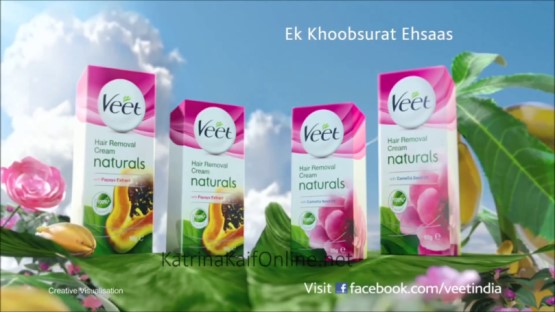
B. 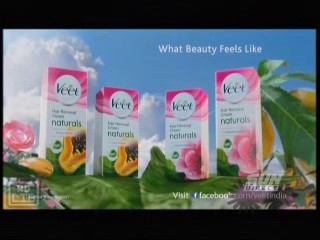
A. The screen shot of the target Ad where we can see the untranslated slogan retained as it is into the Telugu AVT which is retained the same in English.
B. The screen shot of the source Ad where we can see the translated slogan in to Hindi in English script.
The caption of the source Ad “Ek kubhtoorat ehasas….” translated and text is visible on the last frame of the Ad Hindi script in English where as in the target AVT it was retained same as it is in English ‘ what beauty feels like’ which would be from the origin Ad.
|
Source Hindi AVT |
Target Telugu AVT |
|
Dialogues: There are no dialogues by Katrina Kaif in the Ad but a female voice heard (voice over) in the advertisement during entire Ad as background commentary/voice over the moving visuals. |
Dialogues: It is the same similarity here there are no dialogues by Katrina Kaif in the Ad but a female voice heard in the advertisement during the entire Ad as background commentary or voice over the moving visuals. |
|
Background dialogues: Mine paaya kudrath ka ek raaj… |
Background dialogues: Veet yokka kotta naturals range modati saari 100% natural extracts tho paatu….. Miku istundi ade veet yokka glowing maruyu smooth skin gently. Veet naturals ….. Oka andamina anubhoothi” (Slogan translated in to Telugu as a dialogue (voice) but not translated on the screen and kept it as “What beauty feels like”) |
|
Caption:Ek kubhtoorat ehasas…. (Slogan) (Translated and written Hindi script in English) |
Caption: What beauty feels like (in the voice dialogue it was transalted as in the above box last line) |
The equivalence of the source and the target AVT is there are no dialogues by Katrina Kaif in both the Ads but a female voice heard in the advertisement during the entire Ad as background commentary and voice over the moving visuals.
The slogan which was translated in Hindi as “Ek khubsoorath ehasas” in untranslated by the translator in to the Telugu script and left it as it was in English which was as “What beauty feels like”. But as a in the voice over of the last frame of the audio visual the dialogue was translated as “Veet Oka andamina anubhoothi”.
According to Chesterman the serious and challenging role of an audio visual translator is to adapt the translation strategies as believes,
the general characteristics of translation strategies are: to involve in text manipulation, to be goal oriented, the problem centered and the strategies which are to be applied to the process to mediate the lingual and culture systems, and to interpret and interrelate the multi semiotic texts effectively. [3] (Chesterman 1997)
These strategies by Chesterman are very important for a translator to follow to avoid the problems of translation (audio visual) apparently to reach the goal of the translation which is set for the particular mass culture. And the challenges and strategies should be made tentatively for each translation action in accordance with the behavior, attitude, beliefs, of audience and their interactions with the products of mass media.
Case study 2:
The Case Study of Amazon.com
Source AVT
Hindi Commercial Ad - Duration: 2 min
Amazon.com
The opening of the Ad is. While the husband enter the home talking over phone and directly goes to the fridge and looking at the cake he get tempts and takes a piece of it and attempts to keep in his mouth who doesn’t realizes it was the festive day of a north Indian festival ‘karvachauth’, suddenly his wife see him eating it and reminds him of the festival. And so the husband leaves the cake in the fridge and gets to remember that he forgot to bring ‘karuvachauth’ gift to his wife, as it is the tradition or custom of north India to present a gift to wife as they fast for their long lives of their husbands.
List of the characters and the scenes regionally involved in the ad:
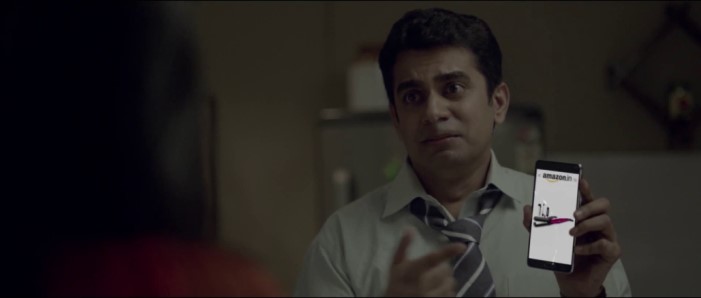
1. Husband who forgot to get gift for his wife and so he opens Amazon.com mobile app and ask his wife who was angry with him to select a ‘Karvachauth gift’ for her.
2. Voice over song starts which conveys a message that ‘amazom.com’ is the best way to shop online which has got so many options to convince your wife who is irritated with the husband. The same song continues to further scenes which continues as to on the screen from the first frame of the advertisement to till last scene among all the scenarios every one asking for options ‘aur dikhavo’.
3. This is a kind of strategy to show that the more options are available only at the website of ‘amazon.com’.
4. There are so many scenarios or background settings of different crowd or family belonging to different cultures and specific regions. In each and every scenario the corus or voice over of the amazon song repeatedly says that ‘Hindusthani heart says “aur dikhao aur dikhao”’.
A) Husband and wife, where husband showing options on mobile app to wife to choose a ‘kaurwachauth gift’

B) A family in a tour at some heritage place of India, where they are trying to take a family photograph in that particular location as a memory as few photographers arrived there and shows them the sample photos, where the family or the husband and wife doesn’t get satisfied and ask the photographer ‘Hindustani dil kehatha hi aur dikhaavo’.
C) Then next scenario is in the aircraft where a Gujarathi family (all women) travels and sings a song about all the dishes (food) of their culture which make the viewers understand from which region they are. They sing the song on hungry and dishes and finally in the last line they used the same line ‘Hindusthani ped pukaare aur dikhao’.
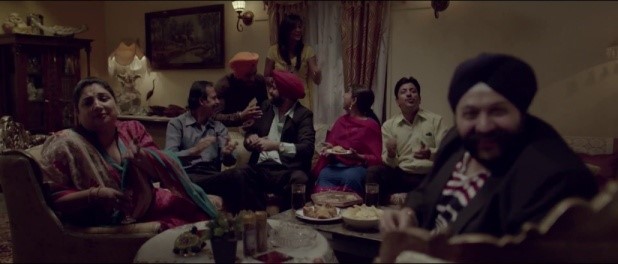
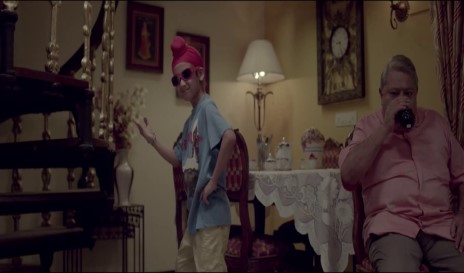
In this frame of the advertisement a Sikh family is shown who is enjoy a dace of a little sikh boy and when he stops the dance one among them asks for more as ‘aur dikhao’ and the chorus comes as Hindusthani darshak bole aur dikhao’.
D) The next scene is at the park where a couple sitting on the chair with their months old baby and mother showing him toys on the tab screen, the baby keenly watches the pictures and when his mom stops the scrolling, the baby starts crying. And again the chorus of the song repeats as ‘hindustani dil kehatha hi aur dikhaavo aur dikhavo’.
E) In the next frame a shop keeper keep saying about the flavours available and the chorus comes as ‘aur dikhaavo aur dikhavo’.
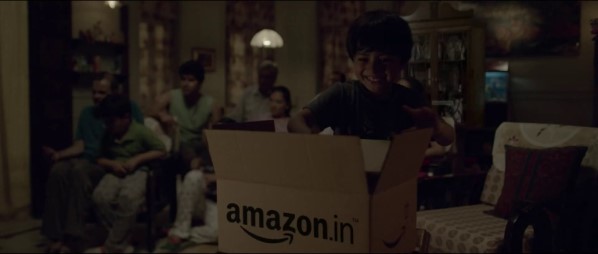
F) And then in the next scene a large family altogether watching a TV serial including the daughter-in-law and mother-in-law of the family. When the old mother-in-law falls asleep while watching a serial the daughter-in-law wakes up her to watch and by that time she wakes up all the serial will come to an end and the old woman (mother-in-law) says ‘aur dikhaavo aur dikhavo..’ and the chorus again repeats as ‘hindustani dil kehatha hi aur dikhaavo aur dikhavo’.
While in the same scene in a corner of the frame of the advertisement we get to see a boy taking out few things from the Amazon box. It appears as if the family do does the online shopping from the Amazon website.
G) The next frame is in a barber shop where the hair dresser asks the costumer for which hair cut he is looking for among the names of the cuts what he has told available as a song and suddenly there was a power cut so he says ‘power cut’ (as a rhyming).
H) The next and the last frame is while a family watching cricket programme and for they ordered online for cricket team shirts for all the family and as apart of their enjoyment and each of them takes one from the Amazon box and wears it and the chorus comes as ‘aur dikhaavo aur dikhavo’.
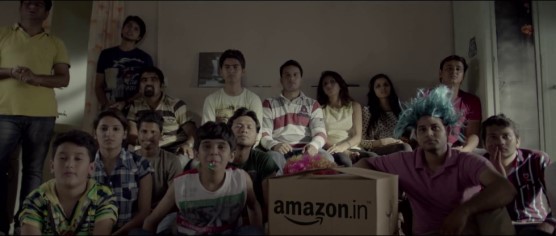
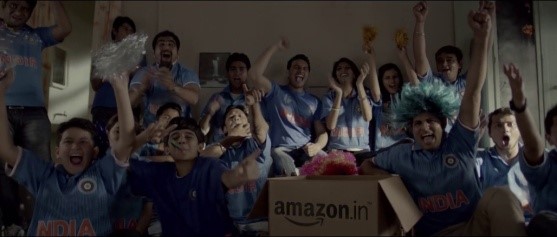
Caption: Ab amazon Ad download kijiye aur parakraar rakhiye choon (to choose) ne ka mazaa….
Target AVT
Telugu Commercial Ad - Duration: 1 min
Amazon.com
In Hindi Ad and as well as Telugu as the scenario is same but the Ad was cut short in to 1min where as Hindi Ad was with the duration of 2mins. There are a lot of scenes deleted to cut short the Ad. Due to this the Ad had lost the originality. But the dubbing song (voice-over) has composed attractively.
The song of the Ad can be seen as the strategy used to employ the Ad in the target ad. But the main scandal in the translation of the Ad is the ‘culture’. The culture was untranslated and retained the same words as and culture as ‘kaurvachauth’ which is a festival non exists in the Telugu region or customs.
In the 1min Ad many of the scenes are removed to confine the Ad to 1min only, inspite of it in the Ad the complete set up was north Indian culture and families like Gujrathi, Punjabi (Sikhs), Uttar pradesh etc.,. These are the scenes (visuals) are retained the same along with the culture and promoted in the Telugu national channels.
In the very first line of the song, the word ‘pellam’ was used for wife, and it is bibi. Usually in a formal Telugu language for wife they say ‘bhaarya’. But in the song they used the word ‘pellaam’ (wife) which is an informal language generally not spoken by respectable people to address ‘wife’.
In the target AVT (Telugu ad) the first scenario of the Ad between wife & husband about the ‘karwachauth festival and the second family wish to take a photograph and then in the third Punjabi family enjoys the little Punjabi boys imitations of the Bollywood heros Ameer, Sharuk and Salman, and in the fourth scenario a family watching a serial including daughter-in-law and mother-in-law, and then in the final frame we get to see a family who are fans of watching cricket match orders T-shirts of Indian cricket team and all of them wears and enjoy watching the cricket.
The main strategy use was to retain the same tune of the source AVT along with the visuals only the frames which are promoting the amazon.com website Ad within as show in the picture down from the advertisement. The translator might be conscious about the duration of the Ad at the same time tried to render all the essence of the source AVT but left the culture and other signs untranslated.
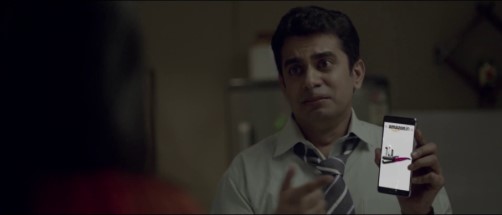
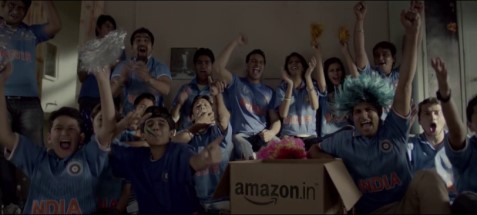
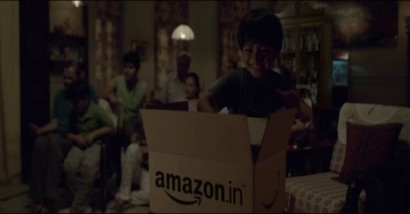
In Hindi the Ad was too long with many scenes but coming to target AVT some of them are cut down but still the visuals of Ad are alien to the Telugu audience due to culture difference. But however the chorus of the song are translated well which acted as registers of the AVT to understand though the visuals are completely contrast.
The chorus of the song in the target AVT:
‘bharatha desapu manase palike inka choopie inkastha choopie’
‘bharathapu desapu prajale adige inka choopie inkastha choopie’
‘bharathapu desapu preakshalu (audience) adige inka choopie inkastha choopie’
Caption: Aamazon aap download chesukondi, ennukovadam loni maza
Suggestion: If the Ad is made globally keeping in view the pan India at least the visuals, the screen translation would have worked out well along with the audio and the chorus. The advertisement would have hit the target market more effectively.
According to Hatim and Munday,
Some main issues of translation are linked to the strategies of form and content of literal and free translation. However the real problems of translation either a text or in an Audio visual file lies on the compatibility of audience. (Hatim and Munday 2004 58)
It is a very tough task to promote the locale product as globalized but seems very easy to localize the globalized product. For every promotion or persuasion of the product, the company relies on the advertisements either print or television (audio visual advertisement). In fact advertisements act as a communicator between the company and the consumers or buyers. In the process of localization (or) globalization of a product through advertisings, it necessarily involves in the translation, since the product where it was launched in a different region with all different lifestyles and particularly different cultures and the advertisement made for the same cannot be promoted as it is in a complete alien country or a region that too by promoting the product by the means of the same source advertisement which was made with the considerations of the source target market. In the same way in order to launch a product the translator should be very particular about the translation of the advertisement and its text keeping in mind about the target market and their region specifications mandatorily the culture. According to Nikhila from the essays ‘Of Breaks and Continues’, TV ads as Multimodal Translations, from the book Textual Travels:Theory and Practice of Translation in India, she says
“In the case of TV advertisement translation, the criterion for judging this translation would not be fidelity or equivalence to a source text, as much as how effective it is as a target text for the target audience. This kind of downplaying of source text and up holding of the skopos or purpose of the target text is reminiscent of the skopos theory in Translation studies one of the functional theories of translation.” (Nikhila 2015 134)
As how the language and culture are intertwined the translation of an advertisement generally involves mostly either dubbing or remaking by using all the strategies as per the culture of the target market group. But mostly remaking does not happen in case of advertisements as it’s a costly affair. Majority of the advertisements are translated through the process of dubbing which is one of the audio visual translation processes or otherwise can be called as type of screen translation. The source AVT since it was originally made for the region where the product is launched. The same AVT is again under goes translation of the screen as text keeping in mind the tastes and strategies should be considered of the target audiences. If suppose the product is a new one the translator should be more region specific being conscious he/ she should consider all the minute thing also to appear which helps in persuading the target consumers. Mostly all these kinds of translations happen through literal translation. In this process of translation consideration of the target culture along with projection the style of the native language speakers with their life style including their attitudes behavior and especially humor is very important. Eventually it gives clarity that it’s very important to pay attention toward the target AVT and its text more than the source. The case studies above explores in tracing out the translation process of the audio visual translation of advertisements from Hindi language (source AVT) to Telugu language (target AVT) especially the advertisements of undivided Andhra Pradesh (AP & Telangana).
Conclusion:
In conclusion the present paper further explains the ideal example of the translated advertisement of Red label tea in Indian context (both source and target) with a case study. Text plays a very important role in any translation. It is a known fact that culture and translation are intertwined and culture should be considered as a part of any language. In India especially, as it a multicultural and multilingual country, each language is in contrast to another. But through translation, the scope to know one another’s cultures is created. This is possible by watching dubbed serials or movies and by reading translated versions of any text in which culture reflects. All this exchange or transfer is majorly possible through media and as we flip through channels, we come across advertisements of several languages allowing us to glance into the respective cultural nuances.
“Rewriting/improving the advertisement in different language could be an attempt at not only expanding its market in a new linguistic territory but a quest for righting the image/brand or a company.”[4] (Nikhila 2015)
Brands today are able to occupy a place in the world market only because of mass communication through well strategized ads in the active media. Ad makers and translators of commercial advertisement or a campaign should keep in mind that “markets are not products, they are people”. An example of the ‘Red Label Ad’, which is made and remade in both the languages, is discussed here. The Ad was remade in Telugu rather than dubbed. In both the languages, the background is that of a set for a television serial shoot where the characters of the serial, ie the mother-in-law and daughter-in-law discuss the letters they have received from the fans of the daughter-in-laws character. In Hindi, the Ad uses the sets of the serial ‘Yeh rishtha kya kehalatha hi’ and in Telugu is the back ground of another famous serial ‘Kala vaari kodalu’.
Red Label Tea Ad-2011-Hindi- Duration: 27secs
The scene in the advertisements is set in a daily serial location between the mother-in-law and daughter-in-law of the famous daily serial ‘Yeh rishtha kya kehalatha hi’.
Dialogues: All the dialogues are by daughter-in-law except one.
Daughter-in-law: Veenu ji likhthi hi, Akshara jab saas sataaye tho mujhe bataana. Ek minute mi theek kardoongi.
(Both mother-in-law and daughter-in-law laugh looking at each other while Akshara reads the above line from the letter written to her by one of the viewers of the serial.)
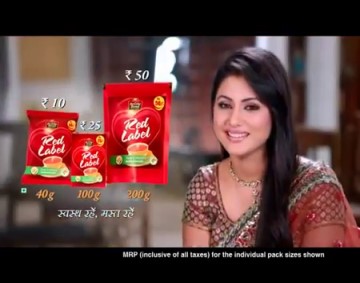
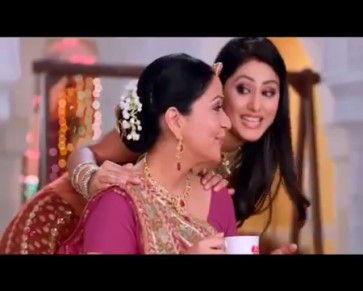
5.3 the searial heroin promoting the Ad ad with a message that Red Lable is not epensive. It is a product which fits in the budget (T Ad)
Daughter-in-law: Vo serial ko hi sach samaj kar bhaitie hi.
Daughter-in-law: Logonki kaise kaise galat faimiya hothi hai na!
Daughter-in-law: Jaise ki Red lable mahangi hi.
Daughter-in-law: Jab ki ye kifaithe hi.
Daughter-in-law: Budget mi bhi. (Akshara drinks a sip of the tea from the cup showing that she enjoys the flavor of the Red Label Tea).
Mother-in-law: Aur healthy bhi.
Daughter-in-law: Humari rishthey ki taraha.
The very important point to note in this advertisement is how the advertisement has an interlinkage with a famous serial. This strategy works well because the Ad is aired during breaks in the serial and the viewers who are mostly women will be easily attracted and choose this tea powder over others. This strategy is used as it is in the Telugu advertisement also but the mother-in-law and daughter-in-law’s characters are replaced by those of a famous Telugu serial.
Red Label Tea Ad-Telugu- Duration: 27secs
Dialogues:
Daughter-in-law: Veena garu ela raastunnaru. Mi atta garu sataaisthe nato cheppu okka nimisham lo aavida bharatham padathanu ani. Aavida serial ni kuda nijam anukunundi.
Daughter-in-law: Ee janala ki kuda elanti apoohalo. Red label tea khareedu ekkuva ani antaru, nijaniki edi entho aadaa aindi. Budget lo ne vuntundi.


5.3 the searial heroin promoting the Ad ad with a message that Red Lable is not epensive. It is a product which fits in the budget (T Ad)
Daughter-in-law: Haaa! ….. (After having a sip of Red label tea. It shows the serial heroine drinks it always along with her mother-in-law)
Mother-in-law: Inka healthy kuda.
Daughter-in-law: Mana anubhandam laga ne. (Both mother-in-law and daughter-in-law smile.)
This case study strengthens the argument in favor of making of an Ad by considering all the tastes and interests of the audience. This is one such Ad which appears natural on the screen and seems relevant for the Telugu audiences and eventually for Hindi audiences too. These kinds of Ads travel well and hit the targets of the company and also the market by achieving the Skopos of the translation function.
To check the accuracy of the language written the translator must continuously refer to trustworthy language sources while writing. The translator must also necessarily possess knowledge of the target domain and command on the colloquial language. The written translation should be cross checked by the person who wrote the original script for the source AVT, to ensure that source skopos and the message is transferred accurately. Also if the translator avoids machine translation, the translated Ad will have the scope to travel across audience disparities more effectively and persuade the consumer to buy the product. The Ad could very well create a need for the product in consumers ultimately leading to the increase in profits of the company and the money spent on a translator (in the place of machine) will also be compensated especially since human translators are more expensive than a machine translation.
In every advertising agency employs a creative translator or dialogue writer. But though it is a costly affair, if there is one more translator with the knowledge of culture and colloquial language the translation can gain equivalence by retaining the message from the source language completely. Any Ad translated by a native speaker of the region which is being targeted by the particular Ad will be successful and will reach the target market group. A wrong translation is a waste of time and money to the company. Though it is a costly affair, appointing a translator each for each of the Indian languages in order to localize the product especially foreign ones will be an ideal strategy. Ads will be launched successfully among the mass and stand to make good profits when relevant strategies are followed. The advantage of having a regional translator as a second translator is, when the Ad is translated from SL to TL, to evaluate if it is carrying the SL message, the translated text of the Ad can be back translated and then by retranslating it into target language, the translator can understand whether the message in the new translation is same as the SL Ad or not. This is especially applicable to MNCS because the Ad is not originally made in India and is imported from a foreign country before it is localized for India. This area of research has a serious dearth of the studies conducted so far and there is a necessity to fill it with better works in the area of audio visual translations.
If the translator spends enough time with the subject, creative thoughts are evoked to craft the translations much better from source AVT to target AVT (or from one text to another). It is very important for any translator to have the service or the product translated. Also, the translator must understand the translation layer by layer. If we look an AVT product which is meant for the translation, it can be compared to an onion which has to be revealed layer by layer to get to the source. The same is true understanding the marketing strategies followed in the making of source. The choice of a text/AVT as source is important. Because a good source will help in targeting better. A good one leads to good results and a bad one leads to not just a failure but also a complete waste of time and money for companies as well as bags a bad reputation. The strategies, cultural differences and untranslatability and other issues intertwined with each other in any output of a translation irrespective of the result whether it is successful or not. In conclusions, proper guidelines for these kinds of translations must be in place to derive greater clarity and relevance for target audiences through the translations by the translators.
Bibliography
Baker, Mona. Routledge Encyclopedia of Translation studies. London: Rouledge, 1998. Print.
---. Translation Studies Vol.II. London and New York: Routledge Taylor & Francis group, 2009. Print.
---.In other words: A course book on translation. London and New York: Routledge. 1992. Print
Bell, Roger T. Translation and Translating: Theory and Practice. London and New York: Longman group UK Limited, 1993. Print.
Chiaro, Delia. "Issues in Audiovisual Translation." Routledge Companion to Translation Studies. Ed. Jeremy Munday. London: Routledge, 2010. PDF.
Chesterman,A. Memes of Translation: the Spread of Ideas in Translation Theory, Amsterdam/Philadelphia: J. Benjamins, 1997.Print.
Chandran,Mini and Suchitra Mathur. Textual Travels:Theory and Practice of Translation in India. Delhi: Routledge. 2015. Print.
Cook, Guy. The Discourse of Advertising. London: Routledge, 2001. Print.
Cui, Ying. “The Goal Advertisement Translation: With Reference to C-E/E-C Avertisements”. Journal of Language & Translation.2009. PDF.
Chakravorty Spivak, Gayatri. “The Politics of Translation.” Outside in the Teaching Machine. New York: Routledge, 1993. Print.
Diaz Cintas, Jorge and Gunilla Anderman. Audiovisual Translation Language Transfer on Screen. New York: Palgrave Macmillan, 2009.PDF.
Dyer, Gillian. Advertising as Communication. London and New York: Routledge, 1996. Print.
Gambier,Yves and Henrik Gottlieb. (MULTI) Media Translation. Netherlands: John
Benjamins Publication co. 2001.pdf.
Gentzler, Edwin. Contemporary Translation Theories. New York: Routledge, 1993. Print.
Hatim, Basil and Jeremy Munday. Translation: An Advanced Resource Book. New York: Routledge, 2004. PDF.
Haribanda, Lakshmi and Amrit Eehta. Translating Alien Cultures. Hyderabad: Booklinks Corporation, 2000. Print.
Munday,Jermey. The Routledge Companion to Translation Studies. New York: Routledge, 2009. PDF.
---. Introducing Translation Studies: Theories and Applications. London and Newyork: Routledge, 2001. Print.
Newmark, Peter. A Text of Translation. Shanghai Foreign Language Education Press: Prentice HaH International VuIO Ltd, 1988. Print.
Orero,Pilar. Topics in Audiovisual Translationt, John Benjamin publications:Amsterdam.2004 .PDF.
Owji, Zohre. “Translation Strategies: A Review and Comparison of Theories”, Translation Journal 17.1 (2013): Web. 22 Sep 2014.
http://translationjournal.net/journal/63theory.htm
Parthasarathy,V. Advertising Concepts and Cases. India: ICFAI University Press,2004. Print.
---. The Changing Face of Advertising. India: ICFAI University Press,2005. Print.
Pym, Anthony. Exploring Translation Theories. London & NewYork: Routledge. 2010. Print.
Robinson, Douglas. Becoming Translator. London & NewYork: Routledge. 1997. Print.
Shuttleworth, Mark and Moira Cowie. Dictionary of Transaltion Studies. London and Newyork: Routledge, 1997. PDF.
Venuti, L. The Scandals of Translation: Towards an Ethics of Difference. London and New York: Routledge. 1998. Print.
Venuti, Lawrance. The Translation Studies Reader. London and New York: Routledge. 2003. Print.
---. The Translator’s Invisibility: A History of Translation. London: Routledge, 1995. Print.
Vermeer, H. J. “Skopos and Commission in Translation Action”. A. Chesterman (ed.), Readings in Translation Theory. Oy Finn LecturaAb, 1989. Print.
Zhisu Zhang, li Li. “Effects of Cultural Differences on Advertising Translation”. Proceedings of International Conference on Education Technology and Management Engineering, 2012 Vols.16. PDF.
Other Web sources:
Veet (Hindi). Advertisement. Youtube. 24 Oct 2013. Television.
Veet (Telugu). Advertisement. Youtube. 26 May 2014. Television.
Amazon.com (Hindi). Advertisement. Youtube. 31 Mar 2015. Television.
Amazon.com (Telugu). Advertisement. Youtube. 02 Apr 2015. Television.
Red Label Ad (Hindi). Advertisement. Youtube. 07 Nov 2011. Television.
Red Label Ad (Telugu). Advertisement. Youtube. 07 Nov 2011. Television.
[2] Chakravorty Spivak, Gayatri. “The Politics of Translation.” Outside in the Teaching Machine. New York: Routledge, 1993. Print.
[3]Chesterman, A. Memes of translation: the spread of ideas in translation theory, Amsterdam/Philadelphia: J. Benjamins publication, 1997.Print.
[4] Chandran, Mini and Suchitra Mathur. Textual Travels:Theory and Practice of Translation in India. Delhi: Routledge. 2015. Print.